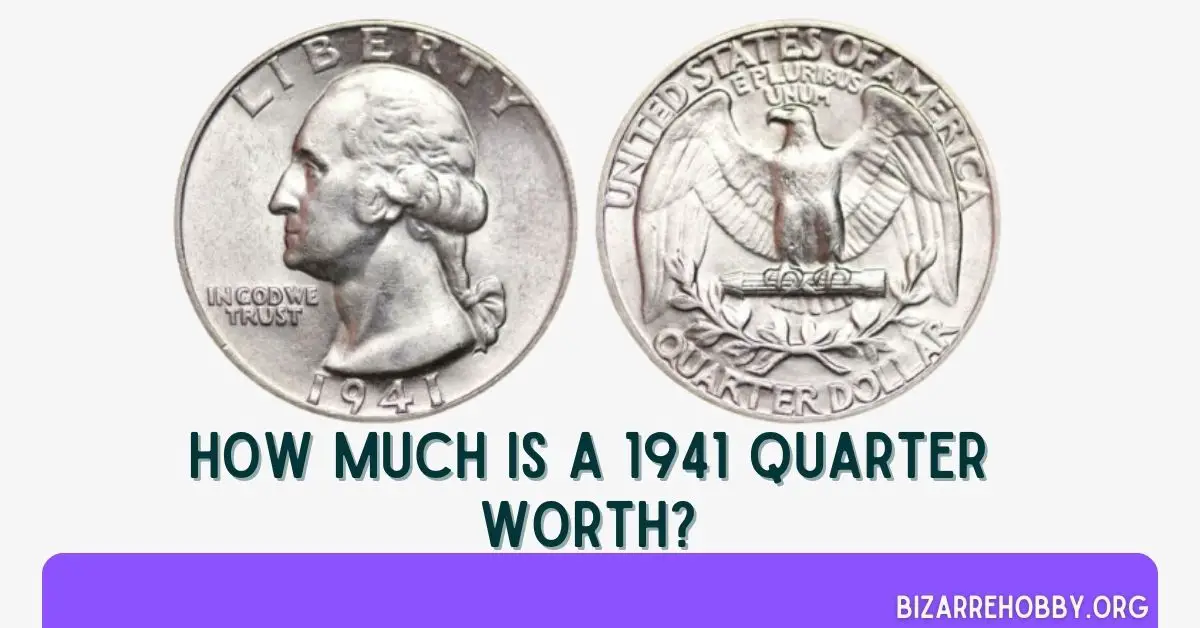The 1941 quarter is part of the Washington quarters series, but how valuable is it? Let’s explore the factors that influence its value, including condition and mint errors that make certain coins highly sought after by collectors.
Value Charts for 1941 Quarter
| Mintmark | XF45 | MS60 | MS65 | MS67 |
|---|---|---|---|---|
| 1941 (P) No Mint Mark Quarter Value | $8 | $12 | $45 | $285 |
| 1941 D Quarter Value | $8 | $28 | $75 | $650 |
| 1941 S Quarter Value | $12 | $36 | $65 | $450 |
| PR60 | PR65 | PR67 | PR68 | |
| 1941 (P) No Mint Mark Proof Quarter Value | $50 | $115 | $325 | $6,500 |
Historical Significance of the 1941 Quarter
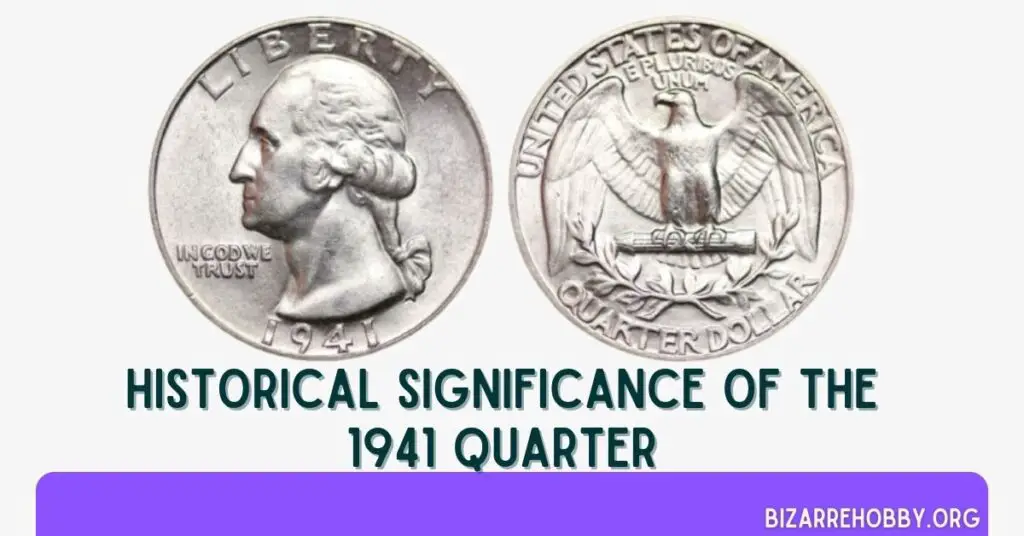
The 1941 quarter is recognizable to anyone familiar with modern U.S. currency. The obverse features a portrait of George Washington, a design that remained largely unchanged until recent years. Unlike modern quarters, which are clad in cupronickel, the 1941 quarters were made of silver.
This coin is part of the Washington quarters series, first minted in 1932 to commemorate the bicentennial of George Washington’s birth. As the anniversary approached, a bicentennial committee was formed to celebrate the occasion, including the creation of a special edition coin.
Initially, it was decided that the Washington quarter would be a permanent addition to U.S. coinage rather than a one-time issue. This decision transferred the responsibility for its design to the Treasury.
The committee had selected a portrait of Washington by Laura Gardin Fraser for the obverse. However, Treasury Secretary Andrew Mellon preferred a design by John Flanagan. After much debate, Flanagan’s portrait was chosen. It wasn’t until 2022, with the introduction of the American Women quarters series, that Fraser’s design was finally used.
In 1941, the Philadelphia Mint produced over 79 million Washington quarters, more than double the output of any previous year. The San Francisco and Denver Mints also produced quarters that year, and the Philadelphia Mint struck a limited number of proof coins.
1941 Quarter Types
| Location | Year | Minted |
|---|---|---|
| Philadelphia | 1941 No Mint Mark Quarter | 79,032,000 |
| Philadelphia | 1941 (P) Proof Quarter | 15,287 |
| San Francisco | 1941 S Quarter | 16,080,000 |
| Denver | 1941 D Quarter | 16,722,800 |
| Total | – | 111,850,087 |
Design of the 1941 Quarter
The 1941 quarter, part of the Washington quarters series, is notable for several distinct features. Let’s delve into the specifics of its design and composition.
Obverse Design of 1941 Quarter
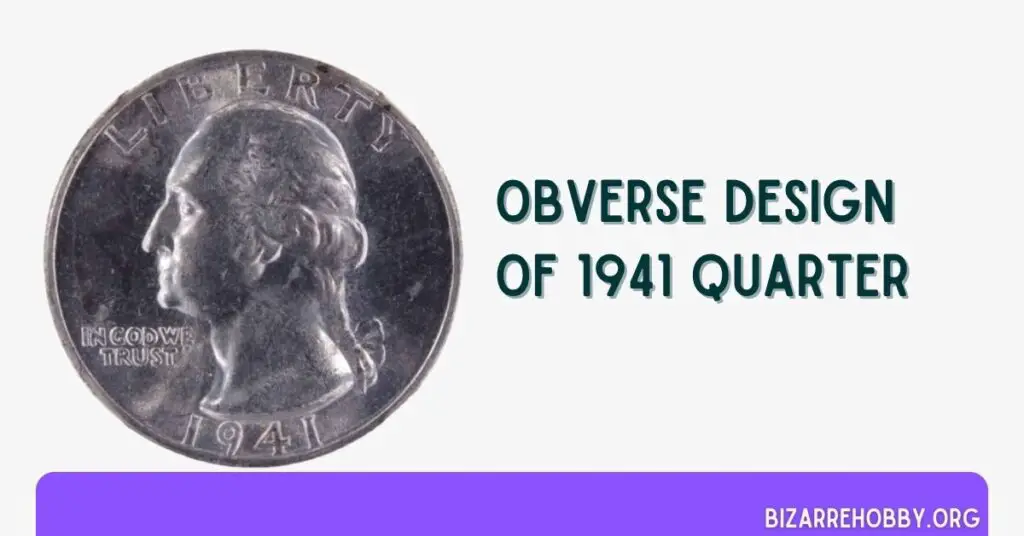
The obverse, or “heads” side, of the 1941 quarter is what earns it the nickname “Washington quarter.” It features a left-facing profile bust of George Washington, the first U.S. president.
This design was the result of a Treasury competition, which required the portrait to be based on a sculpture by French artist Jean-Antoine Houdon. Houdon’s bust was created using a plaster mask of Washington’s face, taken during his lifetime.
The initials “JF” for John Flanagan, the artist behind the winning design, are inscribed at the bottom of the bust. Above Washington’s head arches the word “LIBERTY,” and the familiar motto “IN GOD WE TRUST” is positioned to the left, just below his chin.
Reverse Design of 1941 Quarter
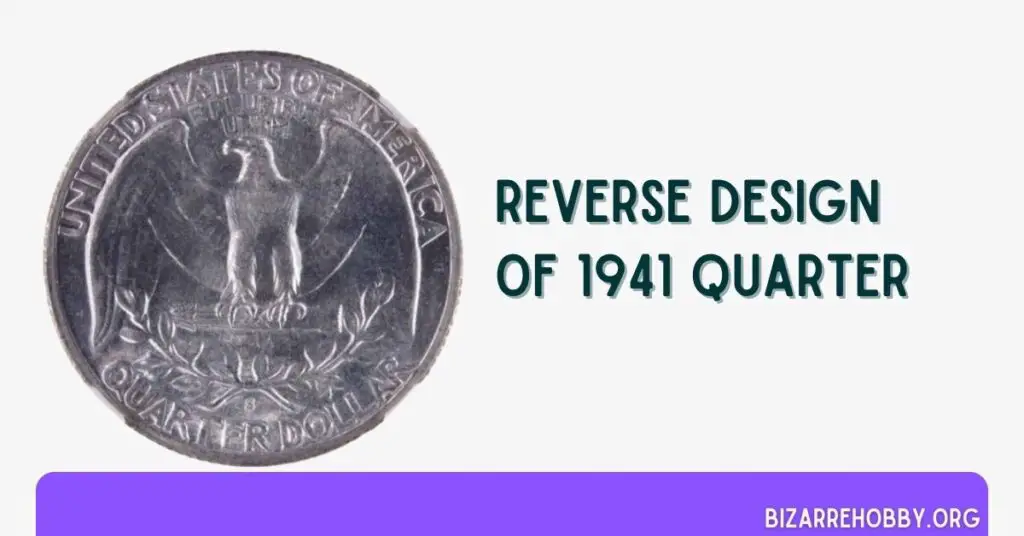
The reverse side of the 1941 quarter, designed by John Flanagan, remained unchanged for Washington quarters until 1998. It features a stylized eagle with outstretched wings, perched on a bundle of arrows, symbolizing the USA. The eagle occupies most of the coin’s surface.
Text is inscribed parallel to the coin’s rim. “UNITED STATES OF AMERICA” follows the upper edge, with the Latin motto “E PLURIBUS UNUM” (“From the many, one”) just below it, above the eagle’s head. Below the eagle is an olive branch tied with a ribbon, symbolizing peace, and the denomination “QUARTER DOLLAR” follows the lower edge.
For 1941 quarters, the mint mark is located on the reverse, beneath the ribbon on the olive branch. A “D” indicates the Denver Mint, an “S” signifies the San Francisco Mint, and no letter means the coin was struck at the Philadelphia Mint, which did not use mint marks in 1941.
Technical Specifications of 1941 Quarter
| Attribute | Details |
|---|---|
| Shape | Round |
| Coin Weight | 0.22 ounces (6.30 grams) |
| Coin Thickness | 0.08 inches (1.95 millimeters) |
| Coin Diameter | 0.96 inches (24.3 millimeters) |
| Edge | Reeded (series of grooves) |
| Compound | 90% Silver, 10% Copper |
| Face Value | Twenty-five cents ($0.25) |
| Text Clarity | Less clear compared to post-1944 quarters |
| Design Note | Date enlarged in dies starting in 1944 |
The 1941 quarter shares the same dimensions as other Washington quarters, with a diameter of 24.3 millimeters. It is composed of 90% silver and 10% copper, making it slightly heavier than modern quarters, which are primarily copper with a cupronickel cladding. The 1941 quarter weighs 6.30 grams, compared to 5.67 grams for contemporary coins.
The coin features a reeded edge, a series of grooves running parallel to the coin faces. This design was introduced in the 18th century to prevent the clipping of precious metal from the coin’s edge.
The text on 1941 quarters is not as sharp as on coins minted later in the series. In 1944, the dies were modified to provide a crisper finish and slightly enlarge the date.
Grading Guide for 1941 Quarter
| Sheldon Scale | Grade |
|---|---|
| 1 | Basal State-1 |
| 2 | Fair |
| 3 | Very Fair |
| 4, 5, 6 | Good |
| 7, 8, 10 | Very Good |
| 12, 15 | Fine |
| 20, 30 | Very Fine |
| 40 | Extremely Fine |
| 50 | About Uncirculated |
| 60 | Mint State |
| 65 | Mint State |
| 70 | Mint State |
Grading a 1941 quarter is essential to determine its value. Coins are graded on a scale from 1 to 70, with 1 being the poorest condition and 70 being perfect mint state. The grading process assesses factors like wear, luster, and any imperfections. Higher grades typically command higher prices, especially for coins in mint state or with unique errors.
Please refer to BizarreHobby’s Washington Quarter Grading Guide to know your coin scale, It’s one of the most crucial steps to know the exact value of your 1941 quarter.
1941 Quarter Value Guides
The value of a 1941 quarter varies significantly based on its mint mark and condition. Let’s explore the value guides for quarters from different mints.
1941 No Mint Mark Quarter Value
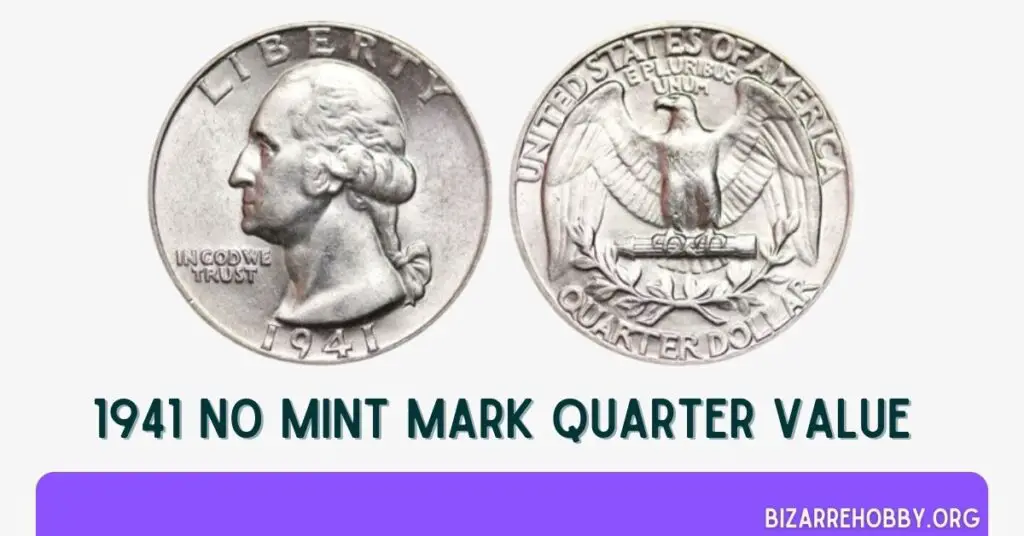
The Philadelphia Mint produced nearly 80 million quarters in 1941, more than doubling its previous highest annual output. The Professional Coin Grading Service (PCGS) estimates that about 7.9 million of these coins still exist today.
Due to their high mintage, 1941 Philadelphia quarters in lower grades are relatively common and modestly valued. However, uncirculated coins are more desirable, as many were carefully preserved.
- XF45 (Extremely Fine): Valued at around $8.
- MS60 (Mint State): Worth approximately $12.
- MS65 (Gem): Valued at about $45.
The finest known 1941 Philadelphia quarter is graded MS68+, with no public sales data available. Five coins graded MS68 are valued at around $17,000 each.
1941 D Quarter Value
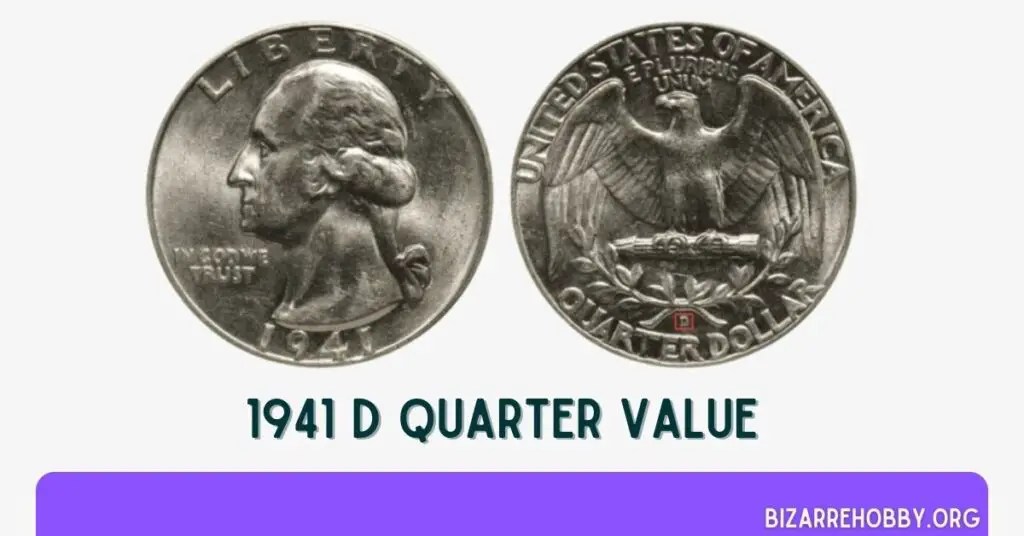
The Denver Mint struck 16.7 million quarters in 1941, slightly more than the San Francisco Mint. Approximately 10% of these coins survive today, with around 20,000 in mint condition and 8,240 considered gems.
- XF45: Valued at around $9.
- MS60: Worth about $28.
- MS65: Valued at approximately $75.
- MS67: Worth around $650.
The finest known examples are four coins graded MS68, each valued at $13,500.
1941 S Quarter Value
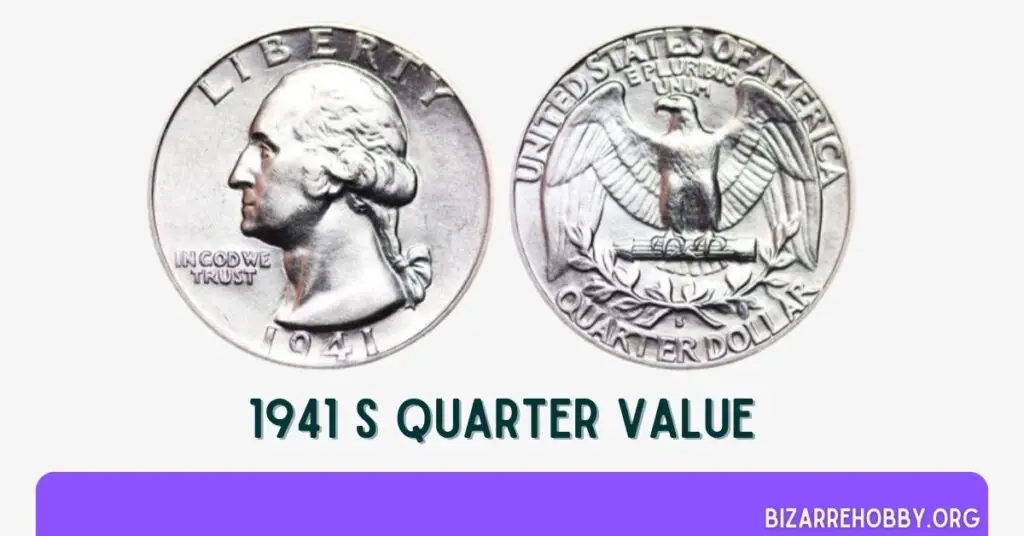
The San Francisco Mint produced just over 16 million quarters in 1941. About 10% of these coins are believed to survive, with roughly 22,700 in mint state. Gem coins are relatively scarce, with around 8,000 surviving.
- XF45: Valued at around $12.
- MS60: Worth about $36.
- MS65: Valued at approximately $65.
- MS67+: Worth around $2,500.
The finest 1941-S quarter, graded MS68, sold for $30,000 at auction in August 2022.
1941 (P) Proof Quarter Value
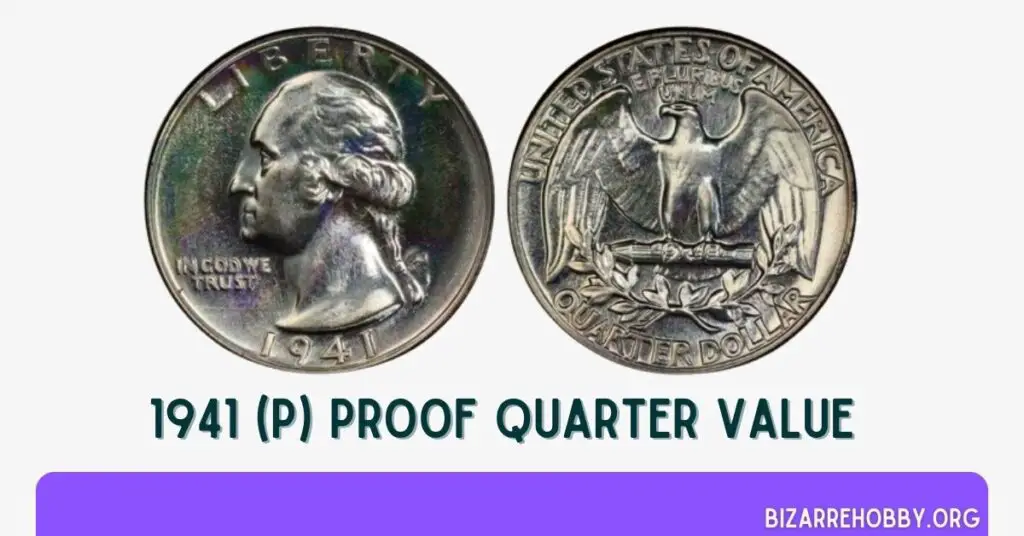
In addition to regular quarters, the Philadelphia Mint produced 15,287 proof quarters in 1941. These coins were made with highly polished planchets and specially prepared dies, aimed at collectors. Despite their high quality and low mintage, they remain relatively affordable due to the high survival rate of around 12,000 coins.
- AU50 (About Uncirculated): Valued at around $28.
- MS60: Worth about $50.
- MS65: Valued at approximately $115.
The highest graded proof quarter, MS68+, has not been sold publicly. However, an MS68 example certified by NGC sold for $3,120 in 2020.
Rare 1941 Quarter Error List
Error coins from 1941 can be particularly valuable to collectors due to their rarity and unique characteristics. These errors often occur during the minting process and can significantly increase a coin’s worth.
Let’s explore some of the notable errors found in 1941 quarters.
1941 (P) No Mint Mark Double Die Obverse Error
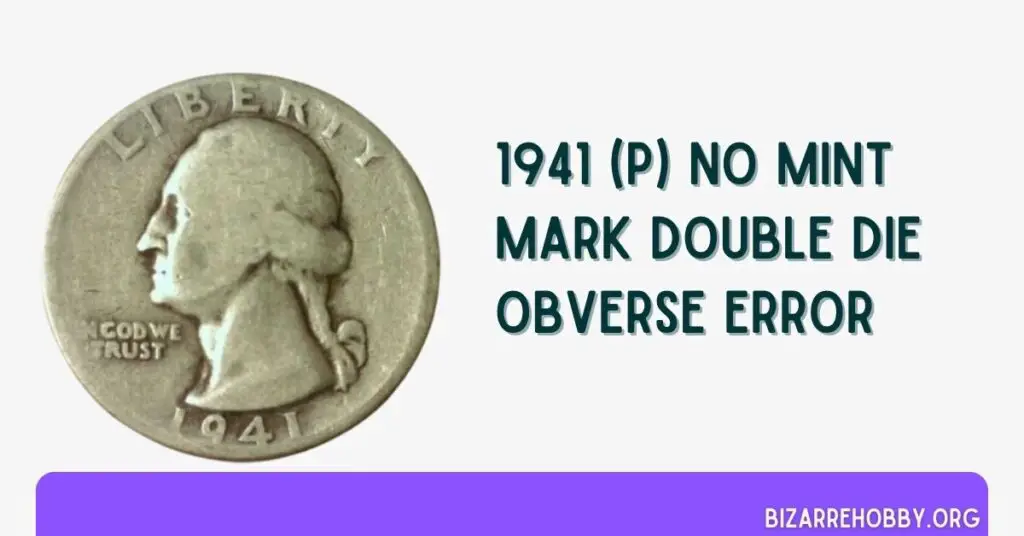
Some 1941 quarters minted in Philadelphia exhibit a double die obverse error. This occurs when the die used to strike the coin shifts during the hubbing process, causing parts of the design to appear doubled. This error is then imprinted on the coins produced with that die.
The value of these error coins varies based on their condition:
- Low Grades (4 or 6): Worth between $8 and $10.
- XF45 (Extremely Fine): Valued at around $25.
- Mint State (MS): Starting at approximately $44.
The highest known grade for this error is MS67. One such coin, certified by NGC, sold for just over $500 at auction in August 2022.
1941 D Double Die Reverse Error
Double die errors can also occur on the reverse side of coins. Some 1941 quarters minted in Denver feature a double die reverse error, which is often most noticeable on the lettering, especially in the country name. A microscope or loupe is typically needed to identify this error.
The value of these coins also depends on their condition:
- AU50 (About Uncirculated): Valued at around $100.
- MS63: Worth approximately $150.
- MS65: Valued at about $250.
Where to Sell Your 1941 Quarter?
Knowing the value of your 1941 quarters is just the first step. Selling them can be done easily online through various platforms. Here are some recommended sites, along with their pros and cons:
- eBay: Widely used, large audience, but fees can be high.
- Heritage Auctions: Trusted auction house, good for high-value coins, but may require consignment.
- Coin dealers: Local or online, offer quick sales, but prices may be lower than auction sites.
If you want to read a post dedicated to selling your coins online, I would recommend reading BizarreHobby’s post on where to sell your coins online.
What to look for in a 1941 Quarter?
When examining a 1941 quarter, there are several key features and factors to consider that can significantly impact its value:
- Mint Mark: Check for the mint mark on the reverse side of the coin, beneath the ribbon on the olive branch. A “D” indicates Denver, an “S” signifies San Francisco, and no mint mark means it was struck in Philadelphia.
- Condition: The coin’s grade is crucial. Look for signs of wear and tear. Coins in mint state (MS) or with minimal wear are more valuable. Use a magnifying glass to inspect the details closely.
- Errors: Identify any mint errors, such as double die obverse or reverse. These errors can significantly increase the coin’s value. A microscope or loupe can help spot these anomalies.
- Luster and Color: A well-preserved coin will have a natural luster and consistent color. Tarnishing or discoloration can affect its value.
- Reeded Edge: Ensure the coin has a reeded edge, a series of grooves running parallel to the coin faces. This feature was designed to prevent clipping of the precious metal.
- Historical Context: Understanding the historical significance of the 1941 quarter, including its silver composition and the design by John Flanagan, can add to its appeal for collectors.
FAQs on 1941 Quarter Value
How much is a 1941 quarter worth today?
The value of a 1941 quarter depends on several factors, including its mint mark, condition, and any mint errors. Coins in poorer condition with an “S” mint mark are worth slightly more than those with a “D” or no mint mark, but the difference is usually only a few dollars. High-grade examples can be worth thousands of dollars.
Is a 1941 quarter made of silver?
Yes, quarters struck in 1941 are composed of 90% silver and 10% copper. This composition changed in 1965, and modern quarters now have a copper core clad in an alloy of 75% copper and 25% nickel.
Final Thoughts
The 1941 quarter is a fascinating piece of American numismatic history, offering both historical significance and potential value for collectors.
Whether you’re a seasoned collector or a novice, understanding the key features, mint marks, and potential errors can help you make informed decisions about your collection. Always consider the coin’s condition and seek professional grading for the most accurate valuation.
